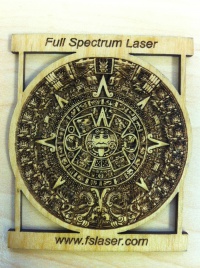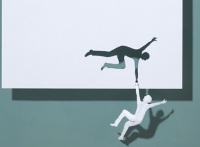Difference between revisions of "Laser Engraving and Cutting"
| Line 53: | Line 53: | ||
*[https://www.youtube.com/watch?v=ww12lImOJ38 YouTube: Image File Formats - JPEG, GIF, PNG] | *[https://www.youtube.com/watch?v=ww12lImOJ38 YouTube: Image File Formats - JPEG, GIF, PNG] | ||
| + | *[https://www.youtube.com/watch?v=W2xknX3k6FY YouTube: How Do Vector Graphics Work?] | ||
==Projects== | ==Projects== | ||
Revision as of 13:19, 30 June 2017
In the December of 2016, the Monmouth College Chemistry Department purchased a Full Spectrum H-Series 5th Generation 45W CO2 laser engraver/cutter. This instrument was purchased, in part, in anticipation of the 2017 MACTLAC meeting where Lon Porter of Wabash College will lead a breakout session on "Fabricating Applications in Chemistry" including 3D printing and laser engraving/etching/cutting. This new instrument will be installed in CSB 373 (Physical Chemistry lab).
Full Spectrum Laser
Company website: https://fslaser.com/
H-Series website: https://fslaser.com/Product/Hobby
- Intro video: https://youtu.be/1ef78vSVo1o
Justification
- We see this type of technology as "cutting-edge" (pun intended). MC would be an early adopter (but clearly after Wabash College) of a technology that will be mainstream in a few years. This fits in well with interests in "entrepreneurial" activities since the technology could be used (and current is) by both sciences and art. Many entrepreneurial businesses are using this technology to do personalized engraving, jewelry making, and paper cutting. This will strengthen our relationship with the Art department.
- Most chemistry departments have a "laser." Although this is not a standard laser that is used to do spectroscopy, we can use this as a VERY interesting example of a laser to discuss the "Light Amplification by Stimulated Emission of Radiation" and other aspects like lenses material (ZnSe). A search of J Chem Ed finds no publication related to laser engraving, but a search of J Chem Ed for "microfluidics" returns 9 papers, none of which use laser engraving as a means of preparing their microfluidic devices.
- We would like to continue to explore microfluidic techniques as it applied to ESR sample preparation; this will be done in both research, quantum (pchem II), and summer research. Having a laser engraver will allow us to make ~300 um (possibly 50 um) channels with any pattern that can be drawn on the computer...or by hand for that matter.
Basic Introduction
Laser: https://en.wikipedia.org/wiki/Laser
Laser Engraving: https://en.wikipedia.org/wiki/Laser_engraving
Laser Ablation: https://en.wikipedia.org/wiki/Laser_ablation
Carbon Dioxide Laser: https://en.wikipedia.org/wiki/Carbon_dioxide_laser
Art Use
Wood: https://fslaser.com/Applications/Wood
Rubber for stamping: https://fslaser.com/Applications/Rubber
Living Hinge: http://fabacademy.org/archives/2015/eu/students/haldin.anders/week3.html
| Wood - Aztec Calendar | Rubber - Rubber Stamp | Wood - Living Hinge | Paper - Falling Man |
|---|---|---|---|
Pinterest example "wood art": https://www.pinterest.com/explore/laser-co2-898859420488/
Pinterest example "paper art": https://www.pinterest.com/explore/3d-paper-art/
File Formats
When using the laser engraver/cutter, you will be working in either "raster" or "vector" mode. You can do both ("raster, then vector" mode) with a single click but this is slightly more advanced. Raster mode is ~equivalent to engraving and vector mode is ~equivalent to cutting. In all cases so far, it has been possible to raster any graphic that can be displayed on the computer screen. Since the Full Spectrum laser acts as a printer, we can say that the laser can raster any image from any program (WORD, InkScape, PowerPoint, etc). This is not the case for cutting or "vector" mode. When in vector mode, the laser follows the outline of the image (and moves much slower) to cut the material. In many cases, when an image is "printed", the raster representation in the RetnaEngrave software looks great, but the vector representation shows only the "box" outline of the image and not the edges needed to vector cut. This issue lies in the file format of the image sent to the printer.
Understanding file formats
At the time of writing this, we are in the process of collecting information about this raster/vector file format issue. The following collection of information may prove helpful...???
Projects
Make a Box
- Once you have created a boxof the desired dimensions, choose print and before submitting, remove the header info (under see more). Also, the file prints with a box around the entire object...cannot seem to get rid of this, so stop the print job once the "outside" box (which prints last) starts.



